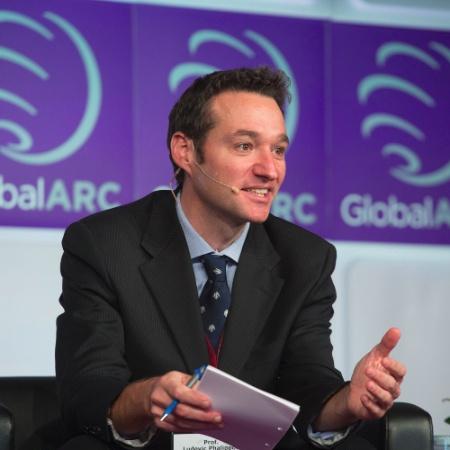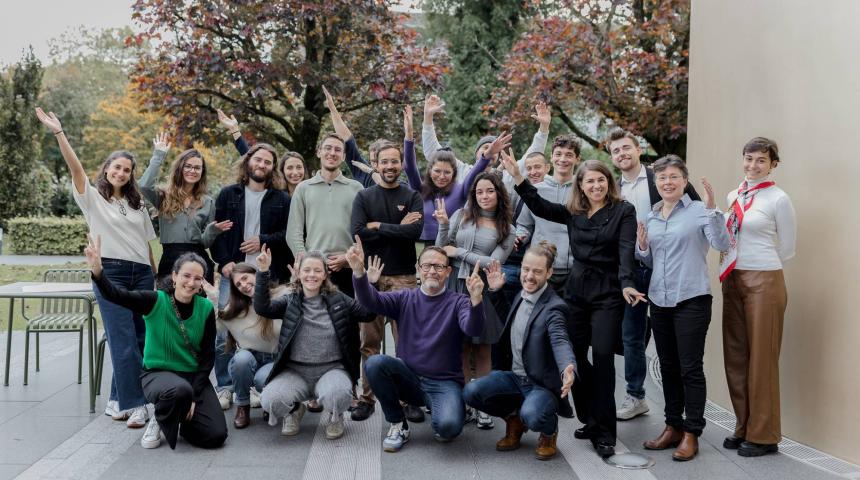Ludovic Phalippou

"Irrespective of their professional background, all participants are genuinely interested and ask questions: it’s also the first time that I have 100% attention and engagement on the part of a group. What is more, these students are asking the right questions – again it is extremely rare to work with a group of students in which all members make relevant contributions that enrich the class experience."
Could you tell us a bit about your background and what you are doing now?
I have a fairly academic background, having studied economics up to the master’s level and then branched into finance, completing a Master’s in mathematical finance and then a PhD. Paradoxically, I am now focusing on topics of a most applied nature: at Oxford, I teach courses on private equity and asset management in the MBA, EMBA and MSc in Financial Economics. When you teach such courses, it is paramount to have a solid understanding of the industry. Given my background, I had to acquire this knowledge by doing research and engaging with the industry. In this context, I was extremely fortunate to be given access to a wealth of data on private equity and, early on in my career, to partner with a researcher who had crossed over from the industry and who could share a wealth of practical knowledge. Conducting research on an applied field, I naturally presented my results at practitioners’ conferences, learning a lot from the feedback. This research and engagement led to opportunities to work with large institutional investors on their private equity investment decisions and benchmarking systems – I gained immensely from working on these types of projects with alternative investment leaders such as the Government Pension Fund of Norway or APG and PGGM of the Netherlands. Now that I am delivering specialised courses to professionals who have industry experience, I am receiving even more feedback on my research and ideas for further work – I am always learning.
What are the different strands in your research – what dimensions of private equity have you have been looking at?
I look at all dimensions of private equity. Mine is a bit of a weird profile because finance academics tend to be classified into corporate finance or asset pricing, whereas I focus on private equity as a theme and cover asset pricing, corporate finance issues, and even some practical, legal, aspects. This is a rare approach, because it is usually a bad idea, from an academic career point of view, to span several areas rather than to specialise – there is a reason why the market clears somewhere else. In private equity, most of the literature is really corporate finance – most researchers have a corporate finance background and look at questions such as whether private equity firms add value for investors and to the economy, differences in the financial management of public corporations vs. companies controlled by private equity interests, etc. I was more of the asset pricing type – actually, the paper I showcased to secure my first academic position looked at the value premium. I have always been more interested in asset management and that is the angle I took to approach private equity and carve a niche there. The literature moved a bit in my direction, but it remains primarily focused on corporate finance; naturally, I also have a number of papers in the mainstream, although they are always borderline really. My work outside of private equity is rare and sporadic, but it’s usually around asset management.
So, given this asset management angle, my work on private equity looks at the practices and the informational needs of asset owners that invest or are contemplating investing in private equity – how pension and sovereign funds are allocating to private equity, what kind of risks they are taking and what returns they are getting, how contracts between general and limited partners are structured and whether these align with the interests of investors or, on the contrary, contain perverse clauses, etc. For example, my publications over the last three years look at the returns and the microeconomic and macroeconomic determinants of performance, the relationship between returns and liquidity or commitment risk, and how to use cash flow data to estimate the risks and returns of non-traded assets.
While the bulk of my work is on private equity funds, which are still the main route for investment, I am keeping a close eye on the development of direct investment by end-investors (i.e. the act of bypassing the funds to manage investments by themselves). In the end, my work relates to asset management of illiquid assets and the types of questions I address are just as relevant for real estate investments or for infrastructure investments.
How do these questions structure the course you are giving in the PhD programme?
The course is given over three days and each day corresponds to a neatly defined session covering a strand of the literature on private equity. The first session is called the law and finance of private equity, the second session looks at the corporate finance aspects of private equity and the final session discusses private equity asset pricing issues. This organisation is quite relevant for an elective since the foundational phase of the PhD has covered each of these topics; we use the knowledge developed in core courses and apply it to a specific industry – in the process, we generate insights on this industry from a variety of outlooks and we also gain a better understanding of the concepts and tools introduced in the first year of the programme as we find out about the their latest applications in the context of private equity.
For example, a significant part of the corporate finance literature looks at whether perquisites enjoyed by CEOs are due to agency problems and a way for top managers to misappropriate corporate surplus that should go to shareholders, or whether these contribute to productivity and increase shareholder value. Is a corporate jet evidence of a conflict of interest in terms of a top manager with discretionary spending or can it make a positive difference to the bottom line by increasing the quantity and quality of the work performed by executives who avoid the hassles of commercial airlines, as these executives would argue? Well, the private equity industry can help shed new light on this much debated question in the corporate finance literature as when a company is taken private by a fund, the private equity interests appoint the CEO and strictly control executive spending to make sure the company is run for the shareholders (i.e. the fund). This takes away the conflict of interest and discretionary spending explanation as regards the existence of corporate jets. So what happens to the corporate jet when a company is taken private really informs this old debate. It turns out that about half of the private jets are sold. On the basis of this research, you can venture that half of the jets are outsized perks and half of them are really needed.
So, we revisit questions that were given a theoretical treatment in the context of foundation courses through the lens of private equity and learn a few things in the process. Besides finding new answers to an old question, this type of review can also help doctoral candidates make creative use of basic tools to address new questions. Look at asset pricing in private equity: how do come up with risk and return figures when you deal with assets that are infrequently and privately traded? Well, let’s look at the tools that have been introduced in the core courses, and find out whether some of them could be used in a different environment to tackle this difficult problem. As long as participants have some interest in private equity, it is a very neat course because it brings together all these things they have studied in their core courses and puts them to life. If core courses are considered theoretical, this is very concrete. And with private equity, everything is more challenging and more, exciting. So, I think such an approach is perfect at the dissertation stage of a PhD programme although there are not too many schools that offer such a course – the field being so narrow and most researchers being highly specialised, this type of course is hard to staff without bringing in talent from multiple institutions, which is not typically done.
The paper that you presented in the context of the programme workshop precisely shows how to extract information about the risk and performance of private equity strategies from cash flow data; could you tell us more about it?
Optimal portfolio allocation requires information about the risk, return, and covariance of asset classes. In liquid markets, these estimates are typically derived from statistical analysis of time-series returns. However, private equity lacks transactions-based performance measures and the only data available are investments and dividends, which occur irregularly during the life of funds, and quarterly, self-reported net asset, values, which are stale and potentially smoothed or otherwise biased. Most private equity time series are based on net-asset-values or on multi-year internal rates of return broken down by vintage years; as such, they cannot be used to produce the type of information required for modern investment management.
The paper introduces a methodology to estimate the latent historical performance of private equity strategies from cash flow data (i.e. contributions by and distributions to limited partners), which allows for the creation of indices for this illiquid asset class and its sub-classes. The key assumption is that the cash flow data are generated by a time-varying portfolio of assets that have unobserved but continuous latent values; the assets are heterogeneous, but we assume their returns are a linear function of an underlying systematic factor structure. The approach is general and is robust to sparse data. It yields time-series that are not based on self-reported values and, I hope, can be trusted. Once you have reliable indices of private equity returns, you can perform the usual statistical analyses and answer fundamental asset allocation and risk management questions that are of great importance to investors and prudential regulators.
Using these time series, we find that private equity returns are only partially spanned by investable passive indices and decompose returns into a component due to these traded factors and a time-varying private equity premium. We find strong cyclicality in the latter that differs according to fund type. As these cycles are not highly correlated, this suggests that a diversified strategy across sub-asset classes of private equity can add value.
How did you get on the contributing faculty for this PhD programme – who approached you and why did you accept the invitation?
I think there are three main reasons why I accepted the invitation. First, I was approached by Professor René Garcia, whom I have known for a while and whom I hold in very high esteem. Then, the list people who are contributing to this programme is extremely impressive and it is a great honour for me to even be mentioned amongst such scholars. Finally, having to structure a doctoral course in your field is an interesting exercise that keeps you on your toes. It’s good discipline to take a good look at the literature, think about how to organise it and convey the key points to doctoral students, and then to go through all the papers in the field to make sure you have understood them thoroughly.
What has been your experience teaching this class?
The small-group nature of the experience was a change for me because for the last ten or so years, I have been teaching MBA classes of one hundred or so students; this reminded me of my own time as a PhD student. I found the experience very interesting – part of the reason is that this is an elective so all participants are interested in private equity: it’s the first time in my life that there is not one person in the class who does not care about the topic. Irrespective of their professional background, all participants are genuinely interested and ask questions: it’s also the first time that I have 100% attention and engagement on the part of a group. What is more, these students are asking the right questions – again it is extremely rare to work with a group of students in which all members make relevant contributions that enrich the class experience. So this is a group that is extremely enjoyable to engage with: everybody is interested, participants come across as smart and mature, all of them ask questions that make sense – those with private equity backgrounds contribute interesting insights and those who do not have that background still have the right thought processes to generate smart questions. It is quite fascinating actually. It’s like a mutant-type group in which you get all the qualities of the participants in the best executive MBA programmes – the industry experience and the great communications skills – and then all the positive traits of your best PhD students. It’s amazing.
What would be your advice to participants embarking on a dissertation with respect to choosing a topic? In your experience as a researcher, what works and what does not?
There is no short answer to that question. Throughout the course, I describe the outstanding research questions and those that have been answered, I give my sentiment on what I think are interesting or uninteresting questions and why, I discuss availability of data to address these questions, etc. These things are woven into the fabric of the course. For each topic we review, I give the big picture, describe the machinery, and from there derive the big questions. Then, I explain which questions have been answered, what kinds of answers have been brought to the table and why they may be partial or unsatisfactory, and therefore what else we could do. This is very useful at this stage of the programme, because in a sense it is really a course about what would or would not be a relevant question for further private equity research.
Obviously this is tainted by subjectivity and I may not be the best person to say what the right questions are exactly. With experience, I have probably gotten better at predicting what could fly and what could not, but it remains a very difficult exercise. At the end of the day, it is up to PhD candidates to decide whether a question is worth pursuing. However, I suggest the following checks. If you are looking at taking the applied route, would the Financial Times or The Economist be willing to listen to you and write a story about your research endeavour? If there are not going to be excited, then it’s probably not a good applied research question. If the work is of a more conceptual nature, the question becomes: would there be a group of people in academe that would be all fired up about your work? If the answer is negative, then it’s probably not a good theoretical research question.



